Back in the day, when I was an industrial chemist I worked on developing emulsions for industrial applications. I would navigate the intricacies of disperse phase versus continuous phase, the hydrophilic/lipophilic balance (HLB) of surfactants and all sorts of other variables. Why is it then, forty years later, I found the thought of making my own mayonnaise to be so intimidating?
Perhaps it was because I would wind up consuming the results of my experiments or perhaps, I didn’t want to waste good food if I stuffed it up. I’m still not sure, but here are the results of my mayo experiments.
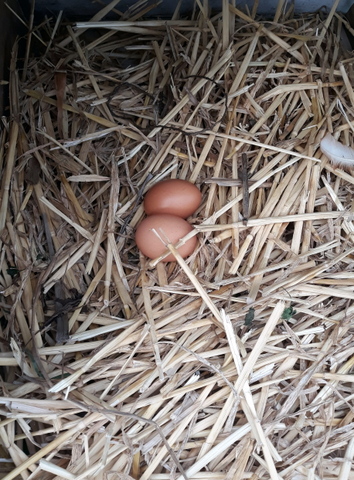
No substitute for home grown eggs!
Why Mayo?
Part of the reason behind these experiments was to enable me to make mayo with what we had on hand any time I felt like it rather than having to buy the commercial stuff. Also, I was hoping to have a homemade product free of preservatives, antioxidants and stabilisers found in commercial mayo.
Another thing is that mayo is a ‘gateway’ product! What I mean is that once you can make mayo, there are many products that use mayonnaise as a base that can become part of your culinary repertoire. Products like tartare sauce, garlic aioli (actually garlic, mustard, BBQ and avocado aiolis) remoulade sauce, blue cheese dressing, caramelised onion dip, plus some stuff that seems popular in the US: ranch dressing. While I probably won’t make them all, I am definitely up for the tartare and aioli!

'Egg salad' made with home grown eggs and homemade mayo!
Also, let us not forget 'salads' by which I mean things like potato salad, egg salad, pasta salad and so on. Having homemade mayo means you can whip up one of these salads on short notice without having to make a trip to the shops. I love it!
The Process and the Raw Materials
I have read both that making mayo is easy and that it is finicky so I did some research. To form an emulsion you need put in energy, either physically or chemically or both. We don’t own a food processor and there was no way I would exhaust myself by using a whisk, so I decided our stick blender would be my weapon of choice.
The oil we use is Aussie virgin olive oil, and I had read that it might be a bit ‘full flavoured’ for making mayonnaise, but I still wanted to use it, so I decided to start off with a 50:50 mix of our olive oil and a ‘neutral flavoured’ oil, in this case avocado oil. In terms of the rest of the raw materials –

or homegrown lemons!
Eggs – would be our own home grown. Some recipes only recommend using the yolk, but I wanted a recipe that used whole eggs. It also seems that they should be at room temperature for the magic to work.
Lemon juice – likewise, our own home grown
White wine vinegar – from the pantry (a bit old but still ok)
Dijon Mustard – I am not a mustard fan, but Linda likes it so we do have some Dijon.
Salt – standard pantry item.
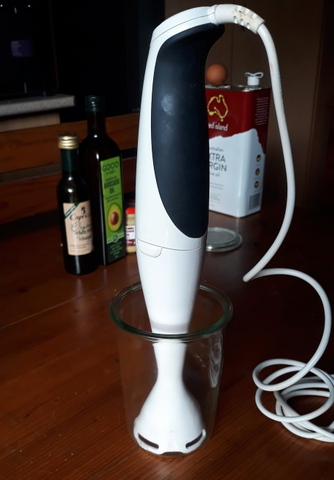
Raw materials plus equipment
Experiment 0ne
My first foray into mayonnaise-ing was based on a recipe from the website ‘Inspired Taste’ (Fail-Proof Homemade Mayonnaise Recipe (inspiredtaste.net) and was listed as ‘Fail-Proof’….. hah!
The recipe was –
- 1 large egg at room temperature
- 1 tablespoon Dijon mustard
- 1 tablespoon red or white wine vinegar
- 1/4 teaspoon kosher salt, or more to taste
- 1 cup (240ml) neutral flavoured oil, grapeseed, safflower or canola are best
- 1 teaspoon fresh lemon juice, optional
What I failed to consider was that the process for making the mayo is critical. I got hold of a glass jar, a ‘Weck’ jar with glass lid, although a vacola jar or any jar the right size would do. It is also critical for the business end of the of the stick blender to fit closely in the bottom of the jar. I then followed the procedure for what one would normally do with a food processor, place the egg in the jar, gave it a whiz for 20 seconds, added everything but the oil in the bottom of the jar, give it another whiz, then with the stick blender going, slowly run in the oil.
Unfortunately, in my case, the recipe may have been ‘fail proof’ but the process wasn’t. The stuff mixed alright, but it did not get any thicker and did not emulsify properly. When I realised it was not working, I tried recommended fixes – add a bit of water, whiz longer, add more egg, add a bit more mustard – and nothing worked. I had broken a fail proof recipe! Regardless of what I did, it split after a few minutes, although before it got too bad I did give it a taste test.
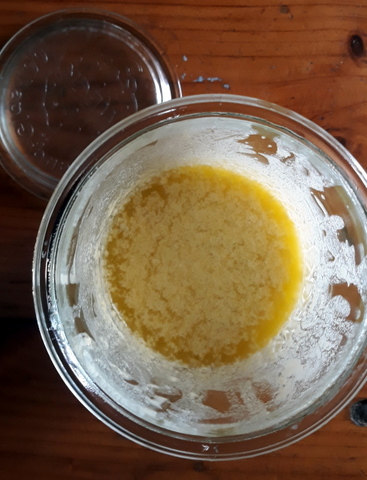
Split!
I learned a couple of things from this experiment. One was that using the wrong type of kitchen equipment (stick blender instead of food processor) just doesn’t work. That and the recipe I used had WAYYYY too much mustard for my taste.
Experiment Two
After recovering from the humiliation of wrecking a perfectly good mayo, I searched the net for a recipe that was designed to use a stick mixer, a whole egg and with much reduced mustard. What I found was a very interesting recipe from Lisa of Downshiftology, Mayonnaise Recipe (Super Easy!) | Downshiftology which seemed to tick all my boxes.
Her recipe was -
- 1 whole egg
- ½ tbsp lemon juice
- 1 tsp white wine vinegar
- ¼ tsp Dijon mustard
- ¼ tsp sea salt
- 1 cup avocado oil, or light-flavoured olive oil
And the process was somewhat different. She said to put the egg first, followed by everything else into the glass jar, with the oil going in last. She said then let things settle for a minute or two, then insert the stick blender down to the bottom of the glass jar, covering the egg. Run it on high for 10 to 15 seconds keeping it firmly on the bottom of the jar. This is critical apparently. Once the mayo starts to emulsify, you can then move it around to incorporate all of the ingredients. You just continue the process until all the ingredients are blended.
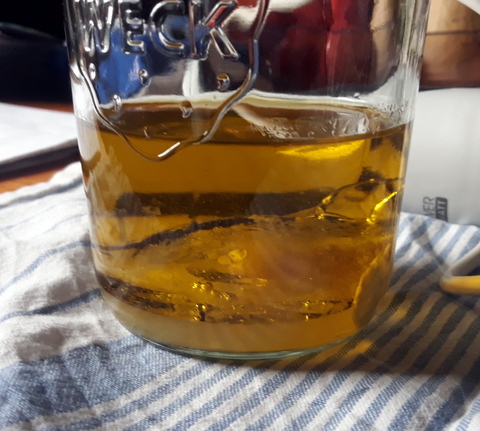
Everything in, allowing time to settle
So, I followed her recipe and process,……..and made mayonnaise!
There was still a slight film of oil on top, which I was able to incorporate when I transferred it to the container before putting it in the fridge. It has a somewhat more yellow look than I am used to, but I think that is due to the rich coloured yolk of our homegrown eggs. It also was still a bit mustardy but nowhere as pungent as my first attempt.
From what I have read, the mayo is OK in the fridge for a week, and by the end of the week it was mostly used up. I found the taste to be fairly mild so it was OK, but I could not help but wonder whether it would be possible to put together a mustard-free mayo, using a whole egg and the stick blender.

More research!
Experiment Three
This one I got from the ‘Simplyjillicious’ website Homemade Mayo (Mustard Free, Paleo) - (simplyjillicious.com) and was touted as being mustard free as well as gluten free, diary free and paleo. (rolls eyes).
The recipe was as follows -
- 1 cup oil (of course I used 50:50 avocado: olive oil)
- 1 egg
- 2 1/2 teaspoons fresh lemon juice
- 1/4 teaspoon salt or more to taste
- 1/4 teaspoon garlic powder
- 1/4 teaspoon onion powder
- A pinch of pepper
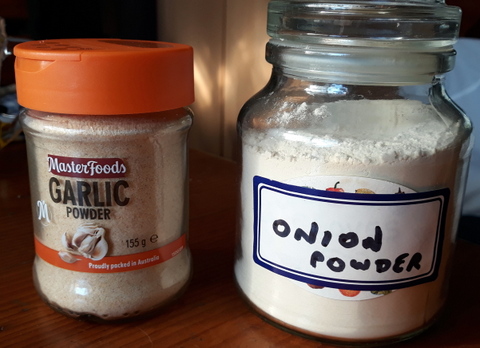
The onion powder was bought packaging free from a bulk store
Process
I used the same process for this mayo as the mayo in the second try, that is to say, I cracked the egg into the Weck jar first, added the lemon juice, salt and spices , then poured in the 50:50 oil, and left the mix to sit for a couple of minutes.
I placed the stick blender at the bottom of the jar and without moving the blender, turned it on high speed for 10 to 15 seconds.
After the initial 10 to 15 seconds I moved the blender all around and up and down until all the oil was mixed in thoroughly and the contents of the jar.
And sure enough, it made mayonnaise!
For obvious reasons, the mayo was not ‘mustardy’, it was fairly mild and quite pleasant. There was a taste wandering around in the background that I think was slightly ‘olivey’ (also for obvious reasons). I do think that this is a mild and pleasant mayo that suits my taste.
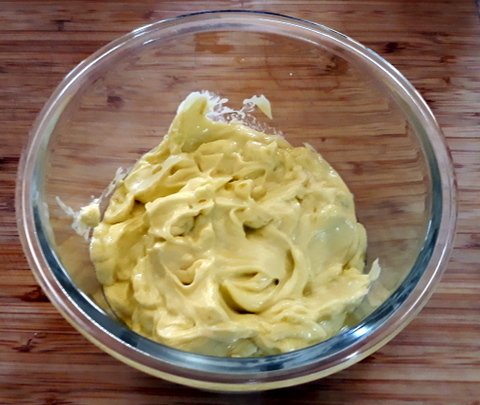
Conclusions
With the right gear and the right recipe you can make mayo quickly and easily
I found the low, and no mustard mayo to be quite palatable


